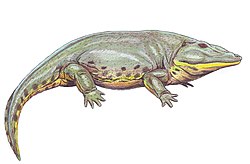| Tirraturhinus Temporal range: Triassic, | |
|---|---|
 | |
| Holotype skull of T. smisseni | |
| Scientific classification | |
| Domain: | Eukaryota |
| Kingdom: | Animalia |
| Phylum: | Chordata |
| Order: | † Temnospondyli |
| Suborder: | † Stereospondyli |
| Family: | † Trematosauridae |
| Subfamily: | † Trematosaurinae |
| Genus: | † Tirraturhinus Nield, Damiani and Warren, 2006 |
| Type species | |
| †Tirraturhinus smisseni Nield, Damiani and Warren, 2006 | |
Tirraturhinus is an extinct genus of trematosaurian temnospondyl within the family Trematosauridae. [1] The type species is T. smisseni. [2]



